Present Tense In Arabic CONJUGATION, 14 Forms And Examples
The present tense is the most common tense in everyday conversations. For this reasons, it’s essential you know the present tense of your Arabic verbs inside out.
Advertisements
Learn the meaning of present tense in Arabic, how to conjugate them and how to identify them with examples.
Meaning Of Present Tense In Arabic
The Arabic word for present tense is called الفِعْلِ المُضارِع. In Arabic, this tense is used to express both habitual and ongoing actions. Arabic present tense have their own signs that distinguish them from other tenses.
All present verbs start with one of the following letters (أ، ي، ت، ن), which are called the present form letters حُرُوفُ الْمُضَارَعَةِ, that is the letters that have to do with the present verb only.
How To Identify Present Tense In Arabic
When dealing with a present verb, one of these four letters (ي-ت-أ-ن) must be at the beginning. So, if you see one of these at the start, you’re probably looking at something that’s talking about the present tense.
Advertisements
Four Prefixes For Identifying Arabic Present Verb
- The Hamza (أ) referring to the first person singular (أنا).
- The Noon (نـ) referring to the first person plural (نحن).
- The Taa (تـ) referring to the person addressed (you أنت) in all genders and numbers.
- The Yaa (يـ) referring to the third person masculine singular, dual and plural; (هو/ هما / هم).
- The Taa (تـ) referring to the third person feminine singular, dual and plural; (هى/ هما / هنَّ).
It is not necessary to be affixed with a letter. In case it is affixed with letters like -āni as in (antumā taktubāni أنتما تَكْتُبانِ), -ūna as in (antum taktubūna أنتُم تكْتُبونَ) and -īna as in (anti taktubīna أنتِ تَكْتُبِينَ), these letters indicate either the dual, plural or feminine.
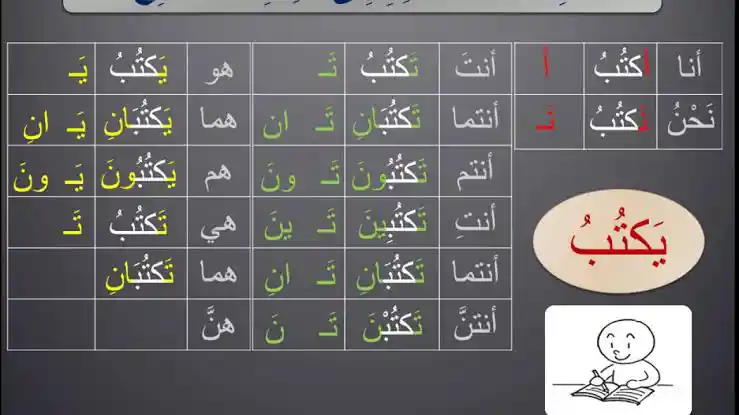
14 Forms Of Present Tense in Arabic
The Arabic present tense verbs are divided into 14 forms according to person, gender and number. Since a verb must agree with its subject in both number and gender, so the shape of present tense verbs in Arabic looks as follows:
| English Pronoun | Arabic Pronouns | Arabic Present Verbs |
| Singular | ||
| I | أنا | أكْتُبُ |
| You (masc.) | أنتَ | تكْتُبُ |
| You (fem.) | أنتِ | تكْتُبين |
| He or it | هُوَ | يكْتُبُ |
| She or It | هي | تكْتُبُ |
| Dual | ||
| We(No dual) | نحن | نكْتُبُ |
| You two (masc. orfem.) | انتما | تكْتُبان |
| They (masc.) Two | هما | يكْتُبان |
| They (fem.) two | هما | تَكْتُبَان |
| Plural | ||
| We | نحن | نكْتَبُ |
| you (group masc.) | أنتم | تكْتَبونَ |
| you (group fem.) | أنتن | تكْتَبُن |
| they (groupmasc.) | هم | يكْتَبونَ |
| they (group fem.) | هن | يكْتَبُن |
- Learn Arabic grammar
- Noun In Arabic
- Demonstrative Pronouns in Arabic
- Arabic Possessive Pronouns
- Arabic Pronouns
Arabic Present Tense Conjugation
In Arabic, verb conjugation is the process of how verbs are derived from a set of base letters (usually 3) and how they change in the different tenses to reflect gender, plurality, voice, and other aspects.
To conjugate Arabic present very tense, Let’s take the base letters س، م، ع, which afford the sense of “hearing”.
Advertisements
The present verb is constructed by placing these letters on the pattern يَفْعَلُ; we get يَسْمَعُ. This verb can mean “he is hearing”, “he hears”, and “he will hear”.
This pattern, like the past tense verb, has three variations. The pattern can be يَفْعَلُ, يَفْعِلُ, or يَفْعُلُ. For. For some purposes, we will simply use and ignore the other variations.
The conjugation table is given below. The Arabic present tense verb has a prefix as well as a suffix. The prefix is one of the following ي, ت, أ, or ن. Arabic present tense conjugation is given in the table below:
Advertisements
Arabic Present Tense Conjugation Table/ chart
| Singular | Dual | Plural | |
|---|---|---|---|
| Third Person (Male) | يسمع | يسمعان | يسمعون |
| Third Person (Female) | تسمع | تسمعان | يسمعن |
| Second Person (Male) | تسمع | تسمعان | تسمعون |
| Second Person (Female) | تسمعين | تسمعان | تسمعن |
| First Person | أسمع | نسمع |
From this, we know that ذَهَبَ means “he went” and يَذْهَبُ means “he goes” ”he is going” and “he will go”.
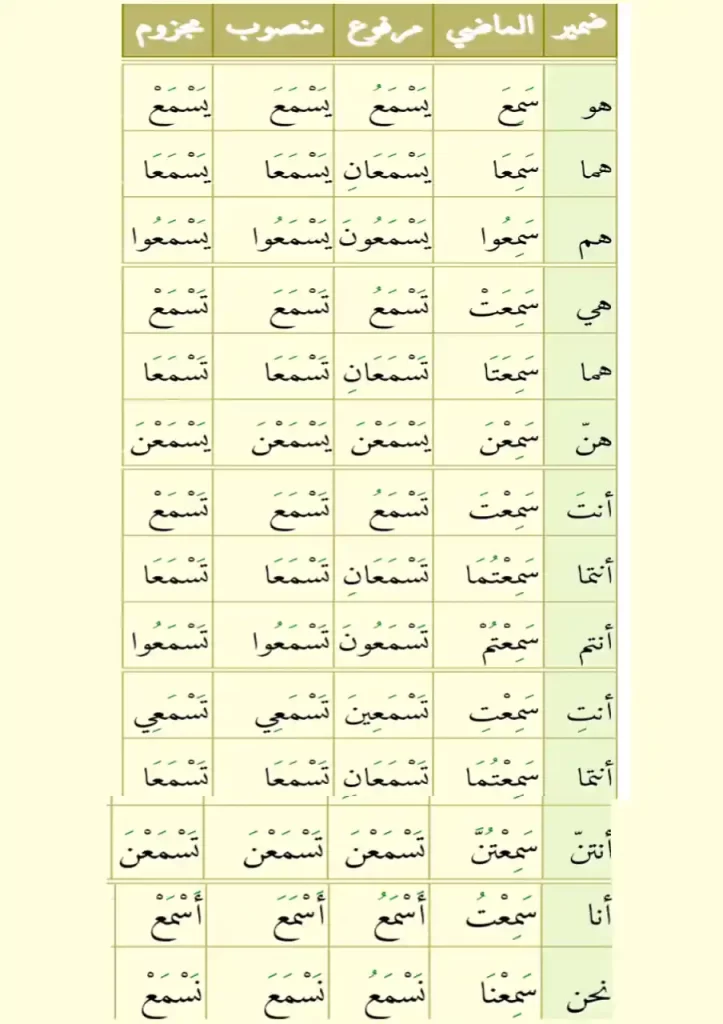
Once you have the base form of a verb (“he”), you automatically know how to say it for “you”, “she”, “I” and “we”, just by flipping the first letter. Example
- He goes – يَذْهَبُ
- You go – تَذْهَبُ
- She goes – تَذْهَبُ
- I go – أذْهَبُ
- We go – نَذْهَب
Just by switching the first letter between ي ,ت, أ and ن you can change the meaning. Also, one of the quirks of the Arabic language is the ت is used for both the feminine and the 2nd person.
To make the verb dual, add انِ at the end. If you’re talking to two people instead of about them, flip the ي to ت
To make the meaning plural (and there is at least one male in the group), put a dhammah on last letter and add وْنَ. If you’re talking to a group of people, change the ي to ت
To talk to a single feminine person/object, put a kasrah on the last letter, add يْنَ at the end, and change the ي to ت
Applying these rules, we get these from يذْهَبُ:
- They both go يَذْهَبانِ
- You both go تَذْهَبانِ
- They all go يَذْهَبُوْنَ
- You all go تَذْهَبُوْنَ
- You[f.] go تَذْهَبِيْنَ
These verbs start with ي or ت, which means that if one of the other two letters used to start present tense verbs (أ and ن) is there , you won’t add anything to the end.
When it comes to female-only groups (more than two), the Arabic language has special rules for them. Instead of using a و to make it plural, we start from the base form and do this.
Put a sukoon on last letter and add نَ. If you’re talking to a group of females, flip the ي to ت. Using these rules, يَذْهَبُ (“he goes”) becomes one of these:
- They (f.) all go يَذْهَبْنَ
- You (f.) all go تَذْهَبْنَ
Like the Five Verbs, the feminine plural form can only start with ي or ت.
We summarized what we have said into table, study the table above.
Don’t forget that this is how they look like in the state of raf’, before anything can come and change them to nasb or jazm.
First case of the present verb is the Raf رَفْعٌ. The present verb is originally in the Raf case.
The second case of the present verb declension is the Ĵazm جَزْمٌ where the case-ending of the last letter changes from the Đammah to Sukūn. Consider the following examples of present verbs preceded by Ĵazm particles “lā” and “lam”:
- The student has not drunk milk لَمْ يَشْرَبِ الطَّالِبُ اللَّبَنَ
So, we can say that a present verb has three cases: Raf (يَشْرَبُ), Naŝb (لَنْ يَشْرَبَ) and Ĵazm (لَمْ يَشْرَبْ).
The second case of the present verb is Naŝb نَصْبٌ, i.e. the case-ending of the last letter is Fatħah فَتْحَةٌ (ـَـ), which is pronounced /-a/. Consider the following examples:
- to sleep ……. يَنَامَ
- to go out ….. نَخْرُجَ
- to prevail …… يَنْتَصِرَ
- to be lost ….. يَضِيعَ
Consider the following examples:
| Raf | Nasb | Jazm | Meaning |
| يَرْفُضُ | يَرْفُضَ | يَرْفُضْ | Refuse |
| يَشْرَبُ | يَشْرَبَ | يَشْرَبْ | Drink |
| يَنْهَرُ | يَنْهَرَ | يَنْهَرْ | Scold |
| يُهْمِلُ | يُهْمِلَ | يَرْفُضَ | Neglect |
Advertisements

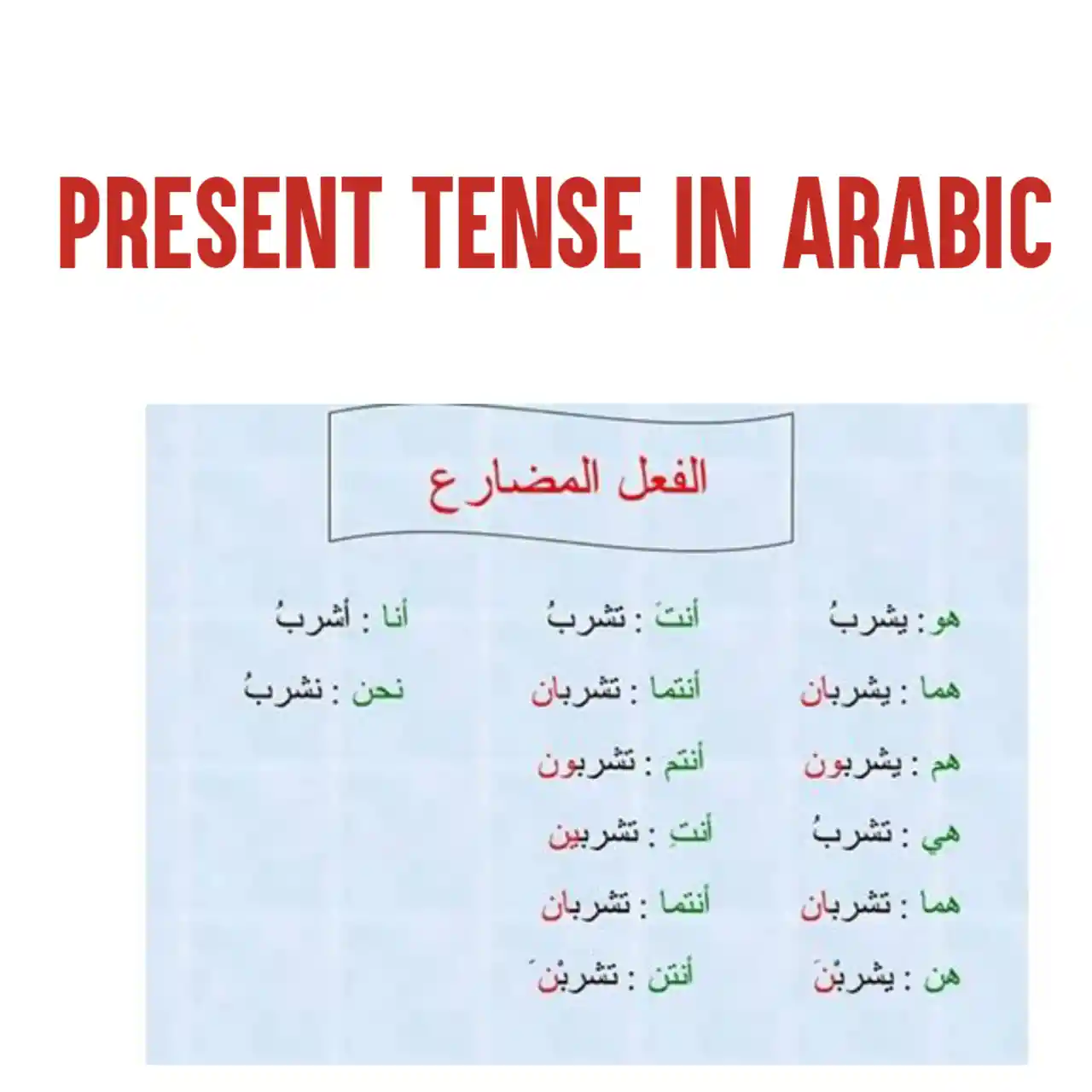
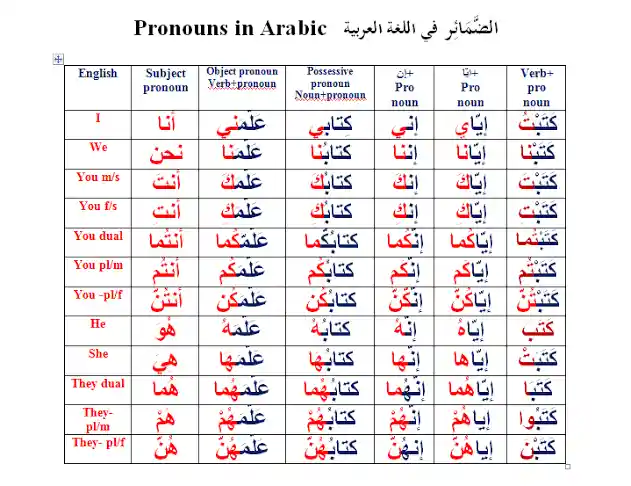

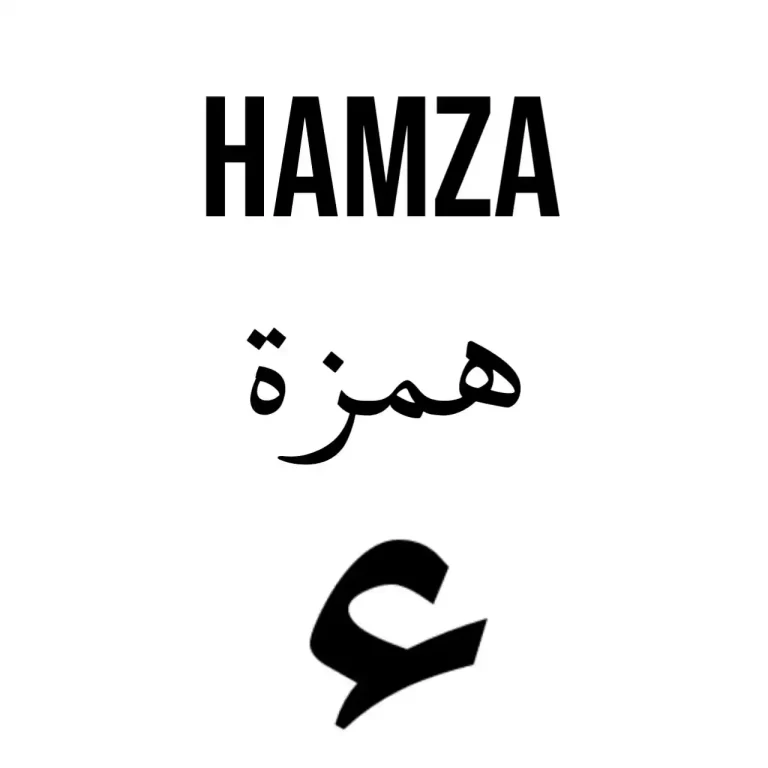
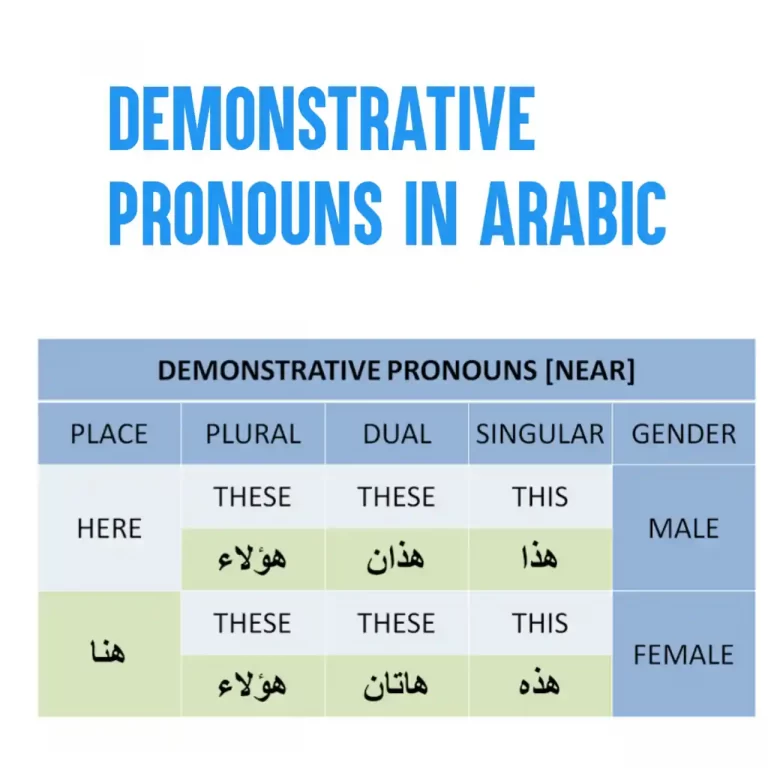
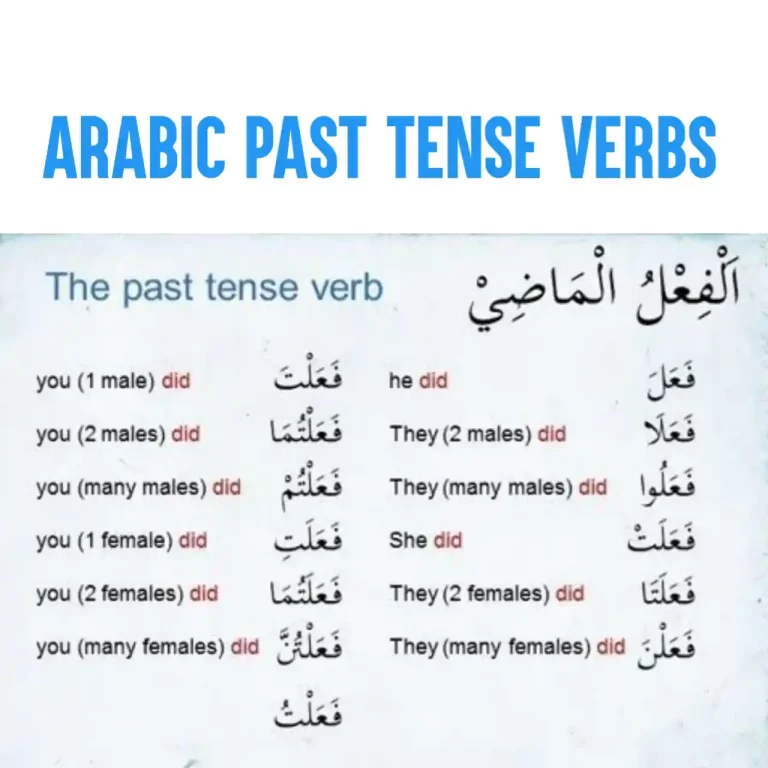
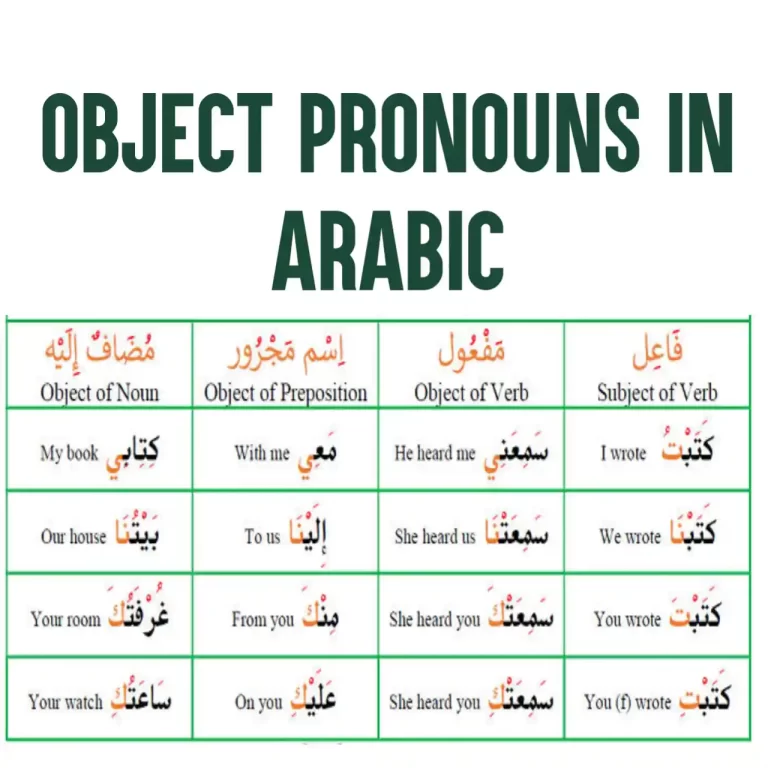
2 Comments